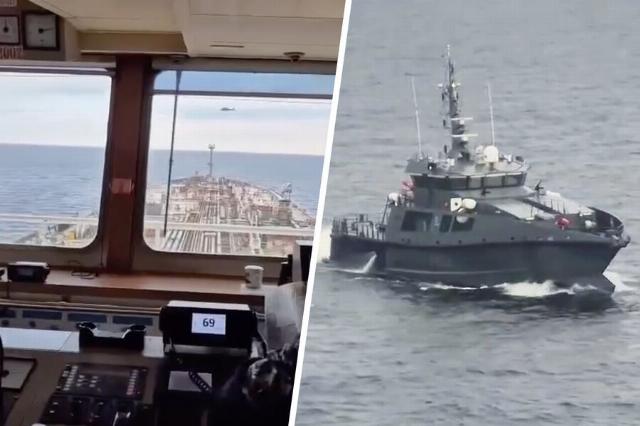The sailors filmed an attempt by the Estonian Navy to stop a tanker bound for Russia
The Estonian Navy, together with NATO aircraft, tried to detain a Jaguar tanker in international waters bound for a Russian port. The Estonian side tried to force him to enter its territorial waters. The Western military tried to ram and land on it from a helicopter. Jaguar was able to evade pursuit after a Russian combat aircraft came to its rescue. Why Estonia was unable to seize the ship and how Russia can respond to such actions is in the material of the military observer Gazeta.Ru", retired Colonel Mikhail Khodarenka.
This story developed as follows. The incident from Tallinn involved the Rayu patrol boat, the Kurwitz patrol ship, an amphibious transport helicopter, a PZL M28 aircraft, as well as Mig-29 fighters of the Polish Air Force.
While the Jaguar tanker (with a maximum cargo capacity of 105 thousand tons), which left the port of Sikka (Gujarat, India), followed its course in the international waters of the Gulf of Finland to the port of Primorsk (Leningrad Region), the Estonian side tried to force it to enter its territorial waters and proceed to the area where the authorities this country could have detained him.
Attempts were made to land inspection teams on the Jaguar from a helicopter (and twice). When this failed, the Estonian Navy boat went to ram the tanker. The Jaguar crew ignored all attempts to detain the tanker and proceeded to the port of loading.
A video has appeared on the Internet depicting an attempt by the Estonian Navy to seize a Jaguar tanker that was heading to a Russian port. The footage was posted on the Telegram channel "Military Observer".
The fervor and zeal of the Estonian side was greatly cooled by the appearance of a Russian Su-35C fighter in the air at a critical moment of the incident. The seizure of the Jaguar tanker immediately became irrelevant, and the forces of the Estonian Navy, helicopters and planes dispersed in the waters of the Gulf of Finland and in the airspace over the Baltic Sea.
How can Russia respond?
There is every reason to believe that Tallinn is playing with fire in such a situation and the patience of the Russian side may someday run out, especially since attempts to seize tankers in the waters of the Gulf of Finland have been taking place far from the first time (Kiwala tankers, Eagle S).
To begin with, the Baltic Fleet Marines can simply launch a series of strikes on the faces of the inspection groups of sailors and Estonian border guards. If basic physical measures do not work, then, we remind you, the Estonian Navy currently includes three Sandown-type minesweepers, one Lindormen-type command and support ship, two patrol boats and four Coast Guard patrol ships.
And if someone in Tallinn thinks that in this case, Article 5 of the NATO Charter will be invoked against Estonia, and the United Naval and Air Forces of the North Atlantic Alliance will stand in orderly ranks to protect the proud Baltic Republic, then this is a clear misconception. In the best case scenario, consultations will begin in Brussels.
And in order to direct the discussion in the Belgian capital in the right direction, the Russian Armed Forces could hypothetically launch strikes, which are single launches of low-power nuclear missiles in order to demonstrate the capabilities of nuclear forces. For example, it could be a low-power high-altitude nuclear explosion over the North Sea. To be visible from Brussels.
So we can unobtrusively recommend that the Estonian military move the boxes of matches away from your playful little hands. Don't play with fire. There may be trouble.
The opinion of the author may not coincide with the position of the editorial board.
Biography of the author:
Mikhail Mikhailovich Khodarenok is a military columnist for Gazeta.Ru", retired colonel.
He graduated from the Minsk Higher Engineering Anti-Aircraft Missile School (1976), the Military Air Defense Command Academy (1986).
Commander of the S-75 anti-aircraft missile division (1980-1983).
Deputy commander of the anti-aircraft missile regiment (1986-1988).
Senior Officer of the General Staff of the Air Defense Forces (1988-1992).
Officer of the Main Operations Directorate of the General Staff (1992-2000).
Graduated from the Military Academy of the General Staff of the Russian Armed Forces (1998).
Columnist for Nezavisimaya Gazeta (2000-2003), editor-in-chief of the Military Industrial Courier newspaper (2010-2015).
Mikhail Khodarenok



